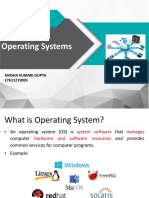Assignment No.
Management Sciences
Management Information System
Submitted to:
Ms. Komal Bashir
Submitted by:
Shameem Naz
Session:
BBA -7 (2016-20)
Difference between Network Typologies
1) Star Topology
A star topology is a topology for a Local Area Network (LAN) in which all nodes are
individually connected to a central connection point, like a hub or a switch. A star takes more
cable than e.g. a bus, but the benefit is that if a cable fails, only one node will be brought down.
Advantages of star topology
Centralized management of the network, through the
use of the central computer, hub, or switch.
Easy to add another computer to the network.
If one computer on the network fails, the rest of the
network continues to function normally.
Disadvantages of star topology
May have a higher cost to implement, especially when
using a switch or router as the central network device.
The central network device determines the
performance and number of nodes the network can
handle.
If the central computer, hub, or switch fails, the entire
network goes down and all computers are
disconnected from the network.
2) Bus Topology
A bus topology is a topology for a Local Area Network (LAN) in which all the nodes are
connected to a single cable. The cable to which the nodes connect is called a "backbone". If
the backbone is broken, the entire segment fails.
Advantages of bus topology
It works well when you have a small network.
It's the easiest network topology for connecting
computers or peripherals in a linear fashion.
It requires less cable length than a star topology.
Disadvantages of bus topology
It can be difficult to identify the problems if the
whole network goes down.
It can be hard to troubleshoot individual device
issues.
Bus topology is not great for large networks.
3) Ring Topology
A ring topology is a network configuration in which device connections create a circular data
path. Each networked device is connected to two others, like points on a circle. Together, devices
in a ring topology are referred to as a ring network.
Advantages of ring topology
All data flows in one direction, reducing the chance of
packet collisions.
A network server is not needed to control network
connectivity between each workstation.
Data can transfer between workstations at high speeds.
Additional workstations can be added without
impacting performance of the network.
Disadvantages of ring topology
All data being transferred over the network must pass
through each workstation on the network, which can
make it slower than a star topology.
The entire network will be impacted if one
workstation shuts down.
The hardware needed to connect each workstation to
the network is more expensive than Ethernet cards and
hubs/switches.
4) Mesh Topology
Mesh topology is a type of networking where all nodes cooperate to distribute data amongst
each other. This topology was originally developed 30+ years ago for military applications, but
today, they are typically used for things like home automation, smart HVAC control, and smart
building.
Advantages of a mesh topology
Manages high amounts of traffic, because multiple
devices can transmit data simultaneously.
A failure of one device does not cause a break in the
network or transmission of data.
Adding additional devices does not disrupt data
transmission between other devices.
Disadvantages of a mesh topology
The cost to implement is higher than other network
topologies, making it a less desirable option.
Building and maintaining the topology is difficult and
time consuming.
The chance of redundant connections is high, which
adds to the high costs and potential for reduced
efficiency.
























































































